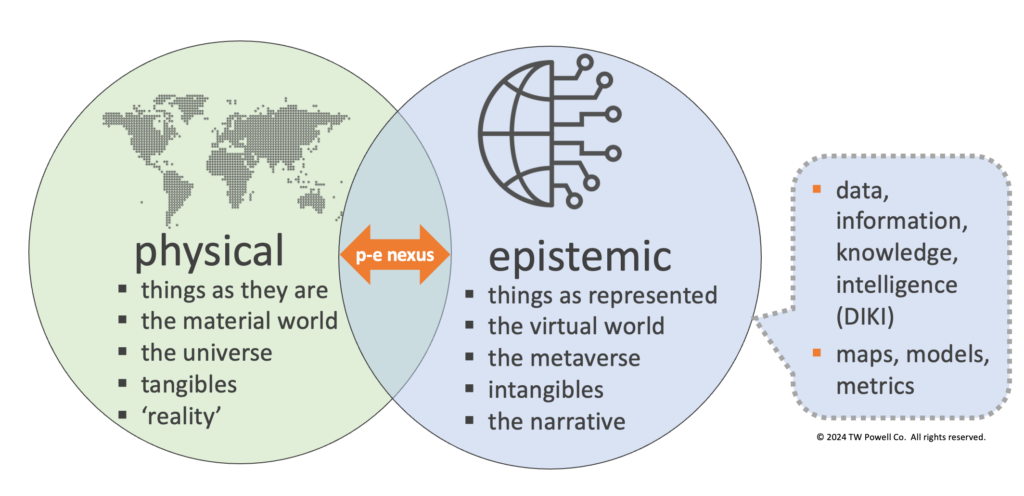
Knowledge Strategy, Uncategorized
PARALLEL WORLDS 1: The Physical and the Epistemic
Being essentially a simple-minded person, I try to boil things down their barest essence. I return often to the symmetry of the two parallel worlds we all inhabit simultaneously: the physical (the material world of people, places, and things that we perceive with our senses — ‘atoms,’ in short) and the epistemic (the virtual world of data, information, ideas, words, numbers, images, and symbols — ‘bits.’) We’ll call these the P-world and E-world, respectively. Understanding the complex relationship between the two can open opportunities and preclude threats.
Understanding the complex relationship between the two can open opportunities and preclude threats.
My first encounters with the miraculous
When I was around four, my mother unwittingly taught me a life lesson that I still find elementally useful. She had recently begun taking classes in ceramics — which included student projects in making pottery. One day she showed me her pencil sketch of a beautiful much-larger-than-life butterfly with spread wings. Though cool enough in itself, this was a mere prelude to the astonishing thing that happened next.
A week or two later, she brought home the actual butterfly — formed out of clay, baked, painted, and fired until it became a gorgeous (and useful) trivet on which to safely rest hot dishes. Any adult would have realized that she had sketched an idea to be then used as a template in crafting the real object. An over-educated adult like me would have seen the sketch as the signifier inhabiting the E-world — and the pottery as its signified from the P-world. But at the time, I experienced it as a miraculous transformation of a drawing into its three-dimensional counterpart.
When in my teens I learned to play music, it seemed another small miracle that I could transform little patterns of print on a page (sheet music — the E-world signifier) into a song (pleasing sound waves in the air — the P-world signified.)
The P-E duality
Some variation on this P-E duality has long fascinated modern western thinkers like Wittgenstein, Saussure, and Baurillard and earlier ones like Kant and Hume — and even further back to the beginnings of our thinking about thinking, for example to Plato in his metaphor of the cave.
Today, the P-E duality is much more than a topic for discussion — it’s a key element in how we work, even how we live. There are over one billion of us ‘knowledge workers’ in the world — an astonishing 12 percent of the population — those whose training and tasks primarily involve manipulations of epistemic resources (data, information, knowledge, and intelligence). While their our work may differ substantially on a task level, at a higher level we all have somewhat the same core purpose: representing the P-world with elements from the E-world — be it words, numbers, graphics, code, algorithms, whatever.
In that sense, we’re each descended from that apocryphal first ‘knowledge worker’ who around 50,000 years ago painted an antelope on the wall of a cave. We ‘model’ some aspect of the P-world on behalf of our clients and ourselves. The model is smaller and far easier to grasp (both literally and metaphorically) than the P-world itself. The more closely our E-world representations match — in structure and function — the corresponding P-world thing represented, the more useful our work has been.
How did this insight help me professionally?
Long before I had a name for it, I’ve leveraged the P-E duality to support my work as a strategy consultant. I began my consulting career in predictive analytics at KPMG — an archetypal E-world gig. We were taking streams of numbers — representing the past and present — and using those to quantitatively ‘model’ real-world trends — including threats and opportunities — in the future. Our clients used our models to make investments in real resources in a future that, though still uncertain, became significantly less so through our efforts. Our E-world work was analogous to switching a car’s headlights to high beams on a dark road — it augmented and enlarged our clients’ understanding of, and agency within, the P-world.
Where do new opportunities come from?
I discovered that this P-E leverage is portable. My analytics base was put to work in designing and developing new products and services that would produce higher margins for PwC. Even in that pre-internet era, the resources we had at our disposal were little more than a grab-bag of E-world ‘micro-signifiers.’ Our raw materials were publications, government and industry data, and conversations with experts. We analyzed and synthesized these to produce a ‘macro-signifier’ (i.e., a business plan). We then socialized the plan the within the firm to generate funding, staffing, training, and marketing — with the eventual goal of building an working business that performed successfully (the P-world signified — and the sole source of the ROI for our efforts.)
That is when I first experientially realized — and tried to harness — the value of knowledge. I became fascinated with this mysterious process that transformed knowledge into real-world results — and awed by the empowering potential of this knowledge resource. So much so that I switched places to become an intelligence provider to business strategists like my (former) self. I transplanted my professional residence to the E-world — and quickly allied myself with smart ‘knowledge people’ who would help me in navigating — with the goal of eventually mastering — the epistemic world.
During my perpetually non-linear career, I’ve been fortunate to work within many subdivisions of knowledge — medical research, market research, competitive intelligence, business strategy, and management consulting. Though their specific tools and techniques differ, seen from a longer perspective their commonalities are more evident. They each serve the same fundamental purpose: building a nexus of E-world signifiers that best describes the signified ‘in real life’ P-world.
But what about the butterfly?
My mother’s drawing of the butterfly was not identical to the butterfly ceramic — let alone, to an actual butterfly. The recipe is not the cake — the map is not the territory — and so on. In short, the E-world signifier is not the same as the p-world signified.
But understanding and leveraging their relationship can provide great benefits. Not only do we work in a knowledge economy, we live in a knowledge world in which we live and breathe a continual epistemic stream of data, information, knowledge, and intelligence. The P-E bond seems so powerful that at times it seems seamless.
And, like the proverbial fish who is said not to realize what water is, we often blur the distinction between the two. Yet as close as we may experience the connection between the signifier and the thing signified, it’s critically important to remember that they are not identical — but rather complementary elements of the same underlying reality.
In the next ‘episode,’ we’ll look at the P-E nexus that connects the physical and the epistemic worlds. ‘Physical’ is the same as what I referred to as ‘phenomenal’ — perceivable by the senses — in previous writings.
Comments RSS Feed